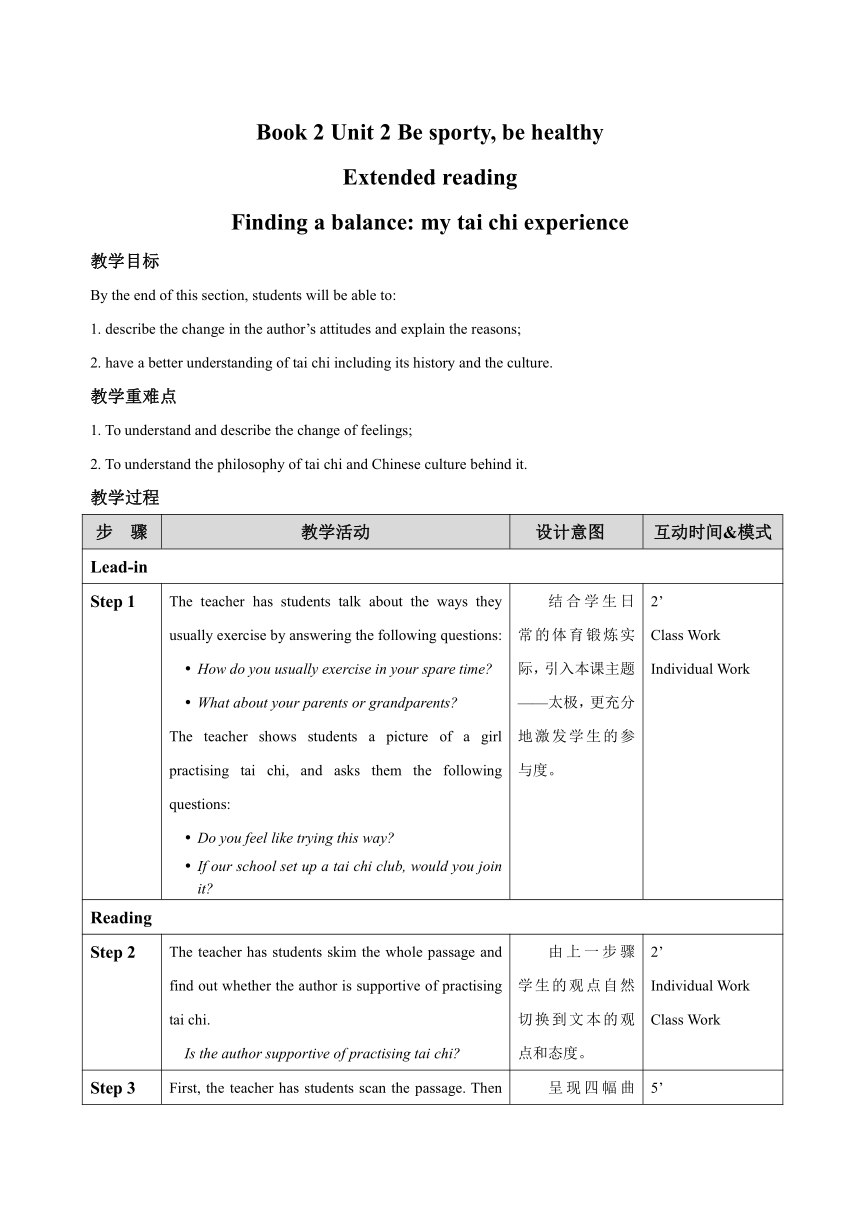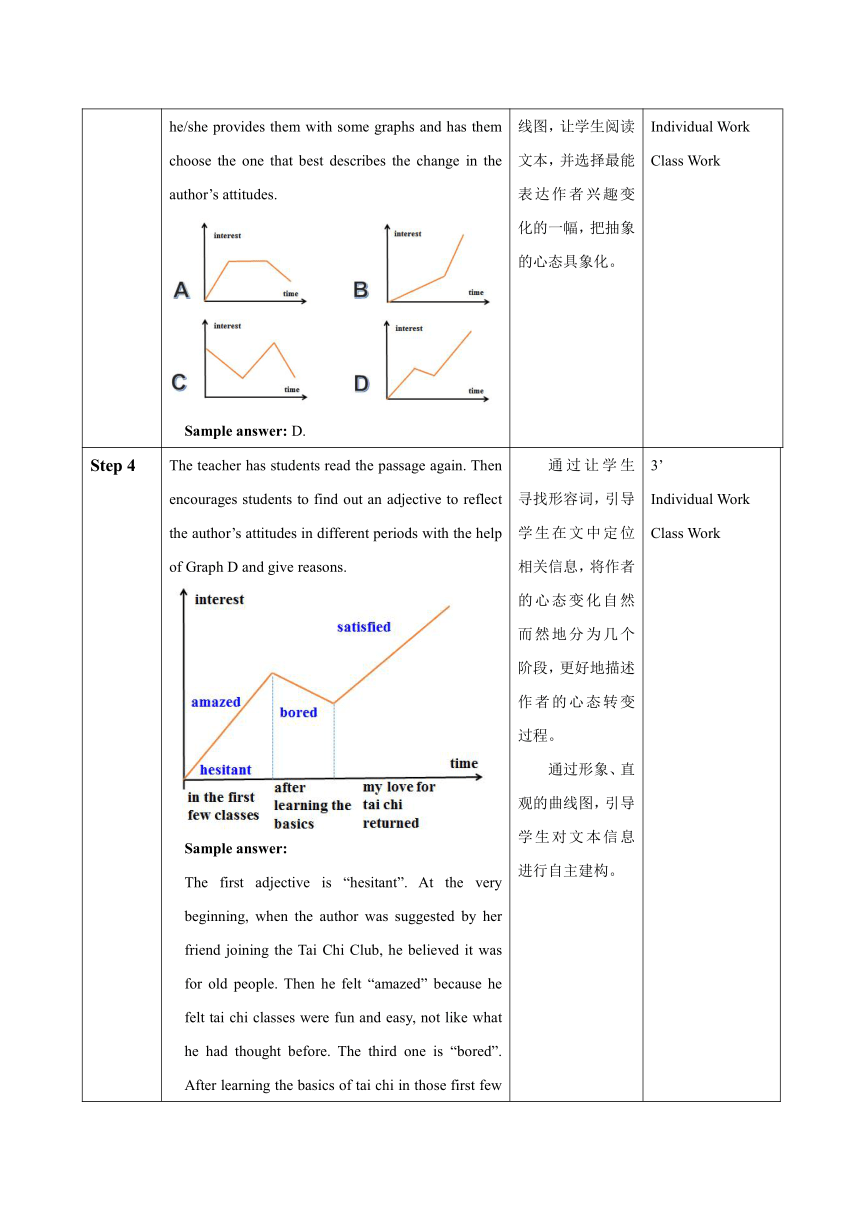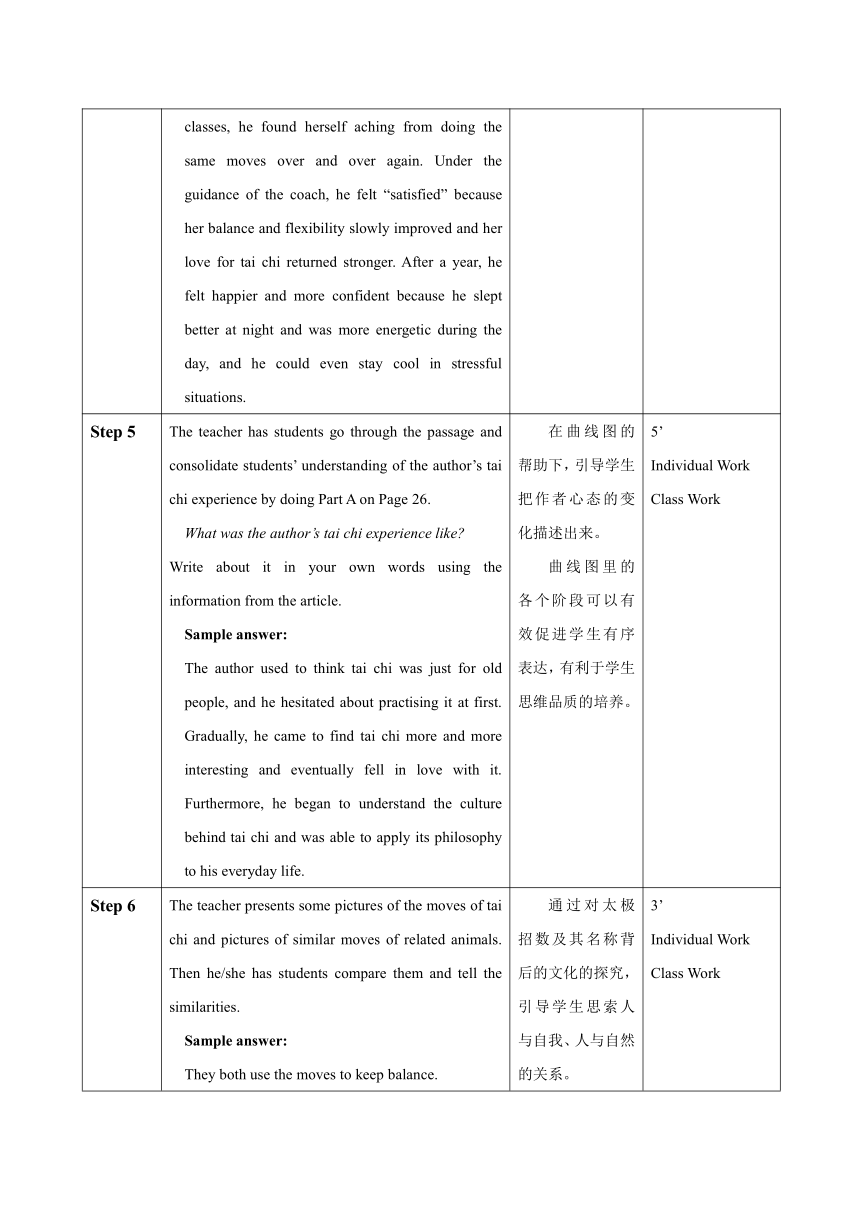牛津译林版(2019)必修 第二册 Unit2 Be sporty,be healthy Extended reading 教案(表格式)
文档属性
| 名称 | 牛津译林版(2019)必修 第二册 Unit2 Be sporty,be healthy Extended reading 教案(表格式) |  | |
| 格式 | docx | ||
| 文件大小 | 96.7KB | ||
| 资源类型 | 教案 | ||
| 版本资源 | 牛津译林版(2019) | ||
| 科目 | 英语 | ||
| 更新时间 | 2022-04-09 22:29:17 | ||
图片预览



文档简介
Book 2 Unit 2 Be sporty, be healthy
Extended reading
Finding a balance: my tai chi experience
教学目标
By the end of this section, students will be able to:
1. describe the change in the author’s attitudes and explain the reasons;
2. have a better understanding of tai chi including its history and the culture.
教学重难点
1. To understand and describe the change of feelings;
2. To understand the philosophy of tai chi and Chinese culture behind it.
教学过程
步 骤 教学活动 设计意图 互动时间&模式
Lead-in
Step 1 The teacher has students talk about the ways they usually exercise by answering the following questions: How do you usually exercise in your spare time What about your parents or grandparents The teacher shows students a picture of a girl practising tai chi, and asks them the following questions: Do you feel like trying this way If our school set up a tai chi club, would you join it 结合学生日常的体育锻炼实际,引入本课主题——太极,更充分地激发学生的参与度。 2’ Class Work Individual Work
Reading
Step 2 The teacher has students skim the whole passage and find out whether the author is supportive of practising tai chi. Is the author supportive of practising tai chi 由上一步骤学生的观点自然切换到文本的观点和态度。 2’ Individual Work Class Work
Step 3 First, the teacher has students scan the passage. Then he/she provides them with some graphs and has them choose the one that best describes the change in the author’s attitudes. Sample answer: D. 呈现四幅曲线图,让学生阅读文本,并选择最能表达作者兴趣变化的一幅,把抽象的心态具象化。 5’ Individual Work Class Work
Step 4 The teacher has students read the passage again. Then encourages students to find out an adjective to reflect the author’s attitudes in different periods with the help of Graph D and give reasons. Sample answer: The first adjective is “hesitant”. At the very beginning, when the author was suggested by her friend joining the Tai Chi Club, he believed it was for old people. Then he felt “amazed” because he felt tai chi classes were fun and easy, not like what he had thought before. The third one is “bored”. After learning the basics of tai chi in those first few classes, he found herself aching from doing the same moves over and over again. Under the guidance of the coach, he felt “satisfied” because her balance and flexibility slowly improved and her love for tai chi returned stronger. After a year, he felt happier and more confident because he slept better at night and was more energetic during the day, and he could even stay cool in stressful situations. 通过让学生寻找形容词,引导学生在文中定位相关信息,将作者的心态变化自然而然地分为几个阶段,更好地描述作者的心态转变过程。 通过形象、直观的曲线图,引导学生对文本信息进行自主建构。 3’ Individual Work Class Work
Step 5 The teacher has students go through the passage and consolidate students’ understanding of the author’s tai chi experience by doing Part A on Page 26. What was the author’s tai chi experience like Write about it in your own words using the information from the article. Sample answer: The author used to think tai chi was just for old people, and he hesitated about practising it at first. Gradually, he came to find tai chi more and more interesting and eventually fell in love with it. Furthermore, he began to understand the culture behind tai chi and was able to apply its philosophy to his everyday life. 在曲线图的帮助下,引导学生把作者心态的变化描述出来。 曲线图里的各个阶段可以有效促进学生有序表达,有利于学生思维品质的培养。 5’ Individual Work Class Work
Step 6 The teacher presents some pictures of the moves of tai chi and pictures of similar moves of related animals. Then he/she has students compare them and tell the similarities. Sample answer: They both use the moves to keep balance. 通过对太极招数及其名称背后的文化的探究,引导学生思索人与自我、人与自然的关系。 3’ Individual Work Class Work
Step 7 The teacher has students read Paragraph 2–3 on Page 25–26 and helps them have a better understanding of the history of tai chi. What are the two different explanations of the origin of tai chi Sample answer: One is Zhang Sanfeng, a 13th-century Taoist. He invented tai chi after drawing inspiration from a fight between a snake and a bird. The other is Chen Wangting, a 17th-century master of Chinese martial arts. He developed tai chi based on martial arts skills. 引导学生探究太极的起源,提升学生对于太极的文化认同,培养文化自信。 2’ Individual Work Class Work
Step 8 The teacher has students read Paragraph 4 on Page 26 and find out the essence of tai chi. 探究太极的本质——阴阳平衡。 4’ Individual Work Class Work
Exploration
Step 9 The teacher has students read Paragraph 4 on Page 26 and helps them to understand the Chinese culture behind tai chi. How do we understand the sentence there is no shadow without light Why is it used here Sample answer: Where there is light, there is shadow. The writer uses this example to explain the equal and opposite forces which make up the world can’t live without the other. 引导学生聚焦文中语句的文化内涵,探究其哲学思辨的特质。 3’ Individual Work Class Work
Step 10 The teacher has students make up such sentences to explain the philosophy of yin and yang. Sample answers: There is no right without wrong. There is no fairness without unfairness. There is no white without black. There is no day without night. There is no success without failure. 引导学生就此进行仿写,促进学生对于阴阳共生、阴阳平衡的理解。 4’ Individual Work Class Work
Discussion
Step 11 The teacher has students discuss the following questions and makes sure students understand the philosophy of tai chi. How do you understand the philosophy between the opposites How do you put it in your life Sample answer: Just as the passage says, the world is made up of opposite forces and neither of them can be independent of the other. The opposites always keep balance and no one could break it. Like days and nights, it always goes from one situation to the opposite. For example, if one fails sometimes, he should never give up. As long as he changes the way he does and thinks, things would be changed. On the contrary, if one succeeds, he shouldn’t be too proud. Keep calm or he will lose. 自然而然地引导学生思考对立统一、阴阳共生的哲学思想,并就此进行表述,提高学生的思维品质和语言表达能力。 5’ Group Work Individual Work
Step 12 The teacher lets students work in pairs to discuss the question in Part B on Page 26. Do you think tai chi will get more popular among teenagers Why or why not Sample answer: Yes, I think tai chi will definitely become more popular among teenagers, because I believe young people are becoming more aware of the importance of physical and mental health. Tai chi is great because it helps with both. This should make it a good choice for teenagers who want to take up exercise. Also, as a traditional Chinese form of exercise, tai chi will probably get a lot of support from the government, schools and other bodies. 在此回归本课话题,探究太极是否会受到青少年的热爱,增强学生对于以太极为代表的的中国文化的认同。 5’ Individual Work Class Work
Homework 1. Write an essay (120 words) to introduce and promote tai chi as a Chinese cultural ambassador. 2. Finish the workbook. 2’
Extended reading
Finding a balance: my tai chi experience
教学目标
By the end of this section, students will be able to:
1. describe the change in the author’s attitudes and explain the reasons;
2. have a better understanding of tai chi including its history and the culture.
教学重难点
1. To understand and describe the change of feelings;
2. To understand the philosophy of tai chi and Chinese culture behind it.
教学过程
步 骤 教学活动 设计意图 互动时间&模式
Lead-in
Step 1 The teacher has students talk about the ways they usually exercise by answering the following questions: How do you usually exercise in your spare time What about your parents or grandparents The teacher shows students a picture of a girl practising tai chi, and asks them the following questions: Do you feel like trying this way If our school set up a tai chi club, would you join it 结合学生日常的体育锻炼实际,引入本课主题——太极,更充分地激发学生的参与度。 2’ Class Work Individual Work
Reading
Step 2 The teacher has students skim the whole passage and find out whether the author is supportive of practising tai chi. Is the author supportive of practising tai chi 由上一步骤学生的观点自然切换到文本的观点和态度。 2’ Individual Work Class Work
Step 3 First, the teacher has students scan the passage. Then he/she provides them with some graphs and has them choose the one that best describes the change in the author’s attitudes. Sample answer: D. 呈现四幅曲线图,让学生阅读文本,并选择最能表达作者兴趣变化的一幅,把抽象的心态具象化。 5’ Individual Work Class Work
Step 4 The teacher has students read the passage again. Then encourages students to find out an adjective to reflect the author’s attitudes in different periods with the help of Graph D and give reasons. Sample answer: The first adjective is “hesitant”. At the very beginning, when the author was suggested by her friend joining the Tai Chi Club, he believed it was for old people. Then he felt “amazed” because he felt tai chi classes were fun and easy, not like what he had thought before. The third one is “bored”. After learning the basics of tai chi in those first few classes, he found herself aching from doing the same moves over and over again. Under the guidance of the coach, he felt “satisfied” because her balance and flexibility slowly improved and her love for tai chi returned stronger. After a year, he felt happier and more confident because he slept better at night and was more energetic during the day, and he could even stay cool in stressful situations. 通过让学生寻找形容词,引导学生在文中定位相关信息,将作者的心态变化自然而然地分为几个阶段,更好地描述作者的心态转变过程。 通过形象、直观的曲线图,引导学生对文本信息进行自主建构。 3’ Individual Work Class Work
Step 5 The teacher has students go through the passage and consolidate students’ understanding of the author’s tai chi experience by doing Part A on Page 26. What was the author’s tai chi experience like Write about it in your own words using the information from the article. Sample answer: The author used to think tai chi was just for old people, and he hesitated about practising it at first. Gradually, he came to find tai chi more and more interesting and eventually fell in love with it. Furthermore, he began to understand the culture behind tai chi and was able to apply its philosophy to his everyday life. 在曲线图的帮助下,引导学生把作者心态的变化描述出来。 曲线图里的各个阶段可以有效促进学生有序表达,有利于学生思维品质的培养。 5’ Individual Work Class Work
Step 6 The teacher presents some pictures of the moves of tai chi and pictures of similar moves of related animals. Then he/she has students compare them and tell the similarities. Sample answer: They both use the moves to keep balance. 通过对太极招数及其名称背后的文化的探究,引导学生思索人与自我、人与自然的关系。 3’ Individual Work Class Work
Step 7 The teacher has students read Paragraph 2–3 on Page 25–26 and helps them have a better understanding of the history of tai chi. What are the two different explanations of the origin of tai chi Sample answer: One is Zhang Sanfeng, a 13th-century Taoist. He invented tai chi after drawing inspiration from a fight between a snake and a bird. The other is Chen Wangting, a 17th-century master of Chinese martial arts. He developed tai chi based on martial arts skills. 引导学生探究太极的起源,提升学生对于太极的文化认同,培养文化自信。 2’ Individual Work Class Work
Step 8 The teacher has students read Paragraph 4 on Page 26 and find out the essence of tai chi. 探究太极的本质——阴阳平衡。 4’ Individual Work Class Work
Exploration
Step 9 The teacher has students read Paragraph 4 on Page 26 and helps them to understand the Chinese culture behind tai chi. How do we understand the sentence there is no shadow without light Why is it used here Sample answer: Where there is light, there is shadow. The writer uses this example to explain the equal and opposite forces which make up the world can’t live without the other. 引导学生聚焦文中语句的文化内涵,探究其哲学思辨的特质。 3’ Individual Work Class Work
Step 10 The teacher has students make up such sentences to explain the philosophy of yin and yang. Sample answers: There is no right without wrong. There is no fairness without unfairness. There is no white without black. There is no day without night. There is no success without failure. 引导学生就此进行仿写,促进学生对于阴阳共生、阴阳平衡的理解。 4’ Individual Work Class Work
Discussion
Step 11 The teacher has students discuss the following questions and makes sure students understand the philosophy of tai chi. How do you understand the philosophy between the opposites How do you put it in your life Sample answer: Just as the passage says, the world is made up of opposite forces and neither of them can be independent of the other. The opposites always keep balance and no one could break it. Like days and nights, it always goes from one situation to the opposite. For example, if one fails sometimes, he should never give up. As long as he changes the way he does and thinks, things would be changed. On the contrary, if one succeeds, he shouldn’t be too proud. Keep calm or he will lose. 自然而然地引导学生思考对立统一、阴阳共生的哲学思想,并就此进行表述,提高学生的思维品质和语言表达能力。 5’ Group Work Individual Work
Step 12 The teacher lets students work in pairs to discuss the question in Part B on Page 26. Do you think tai chi will get more popular among teenagers Why or why not Sample answer: Yes, I think tai chi will definitely become more popular among teenagers, because I believe young people are becoming more aware of the importance of physical and mental health. Tai chi is great because it helps with both. This should make it a good choice for teenagers who want to take up exercise. Also, as a traditional Chinese form of exercise, tai chi will probably get a lot of support from the government, schools and other bodies. 在此回归本课话题,探究太极是否会受到青少年的热爱,增强学生对于以太极为代表的的中国文化的认同。 5’ Individual Work Class Work
Homework 1. Write an essay (120 words) to introduce and promote tai chi as a Chinese cultural ambassador. 2. Finish the workbook. 2’
